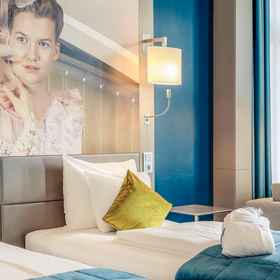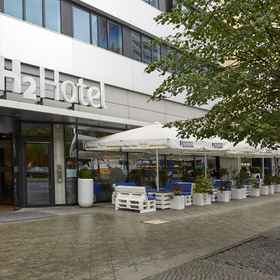
Hotels in Germany
Destinations to Discover




Popular Hotels in Germany
Discover what you like
Register to Use Your Coupon
Up to S$ 30 Flights
8% off Hotels
8% off Attractions
10% off Car Rental
12% off Airport Transfer
More about hotels Germany
The Federal Republic of Germany, or simply known as Germany, is a country that is located in Central and Eastern Europe. The country is flank by the North Sea at the northwest side and the Baltic Sea at the northeast side. The beautiful mountain range of Europe, the Alps, is also cross into the borders of Germany. The Alps, or Alpen in the German language, is located on the south side of the country. Several countries share their borders with Germany. Denmark shares its border with north of Germany, the Czech Republic and Poland are on the east side, with Austria have its border stretching from the east to the south of German. The south of German also shares its border with Switzerland. On the western side of the country, it shares the border with several countries which are France, Luxembourg, Belgium and the Netherlands. Germany border covers an area of about 350 thousand square kilometres. The country is divided into 16 constituent states with nearly 83 million people. German is the second most populous state in Europe right after Russia. It is also the most populous country in the European Union.
The history of German started at least 600 thousand years ago. Various Germanic tribes had inhabited since ancient times. Germanic tribes and people are referred to those who spoke one of the Germanic languages. The early Germanic peoples were said to occupy most of Northern Germany during the Bronze and Iron ages while Celtic-speaking peoples were in Southern Germany. In the first centuries BC, the Germanic tribes began to expand southward into now-Southern Germany, and instead of displacing the Celtic-speaking people, they were assimilated into the Germanic tribe.
In about 50 BC, Julius Caesar’s brought the Romans into contact with the Germanic and Celtic tribes because of the Gallic Wars. The Romans began attacking the Germanic tribes, and wars erupted between them. The Romans gave up on the idea of conquering the Germanic tribes when they lost terribly in the Teutoburg Forest in 9 AD. The Germanic tribes then lived on both sides of Rhine and dominated the areas, living peacefully with the Romans.
In the 10th century, the German territories began to form a central part of the Holy Roman Empire and had their history intertwined. The northern regions became the centre of the Protestant Reformation in the 16th century.
When the Holy Roman Empire collapsed in the early 19th century, the German Confederation was formed. It was an association of 39 German-speaking states in Central Europe, including the non-German-speaking Kingdom of Bohemia and Duchy of Carniola. The German Confederation was to coordinate the economies and replaced the Holy Roman Empire that had been dissolved. German Revolutions of 1848-49 happened in the states of German Confederation as to show that the people were discontent with the traditional, autocratic political structures on the states in the Confederation. These revolutions resulted in the Frankfurt Parliament and establishing major democratic rights.
Germany finally became a nation-state when most of the German states unified under the German Empire in 1871. The German Empire was replaced by the parliamentary Weimar Republic after World War I and the revolutions of 1918-19. The Nazi took over the power in 1933 and ruled under a dictatorship. They were responsible for World War II and the Holocaust of the Jews. When the Nazi lost and World War II ended, the Allied-occupied the country for a while. Two German states were founded; West Germany by the American, British and French, and East Germany by the Soviet Union. German was reunified in 1990 with the ended of communist rule in Central and Eastern Europe.
Today, Germany is a federal republic state with an elected president. The capital of Germany is in Berlin. It is one of the great power nations with a strong economy with a very high standard of living. German also upholds the universal health care system, and give tuition-free university educations.
The primary language in Germany is German. Standard German is a West Germanic language, tracing back to the Germanic tribes. Regarding religions, most people in Germany identified themselves as Protestant Christians, followed by Muslims and Roman Catholics.
Tourism is booming in Germany as it is the seventh most visited country in the world, contributing over EUR 43.2 billion to the economy. Germany receives more than 30.4 million international tourists in the year 2012. It is very well known for its diverse tourist’s routes such as the Romantic Road, the Castle Road and the Avenue Road. These routes are essentially the ‘theme’ for the locations along the roads. Germany also has astounding landmarks scattered throughout the country.
How to Get There
By Flight
The easiest way to travel to German from Singapore is by taking a flight there. Four flights per week go to Berlin, the capital of Germany, or several other major cities in the country such as to Frankfurt, Munich and Dusseldorf. A direct flight from Changi International Airport in Singapore to the Berlin Tegel Airport, Berlin, will take approximately 13 hours and 10 minutes. A return ticket can cost as low as S$679, depending on the airline and promotions during the time of purchase.
A Singaporean passport holder does not require a visa to enter Germany, provided the stay is less than three months. For anyone who wishes to stay longer, a visa must be obtained from the German Embassy in Singapore before flying to German. The passport should be valid for at least six months on the date of flying in.
What to Do There
Neuschwanstein Castle
This is a fairytale-like castle that is built in the middle of the Bavarian Woods in the southwest of Bavaria. This is the castle that acted as the ‘blueprint’ of the Disneyland’s Sleeping Beauty castle. This 19th-century Romanesque Revival palace was commissioned by Ludwig II of Bavaria, King of Bavaria from in the year 1864 until 1886, as a retreat palace and in honour of Richard Wagner, a German composer. The inspiration and design on the palace came from the reconstructed Wartburg, a Middle Age castle in the town of Eisenach, Germany, and the Chateau de Pierrefonds, a historic palace in France. King Ludwig II found these two buildings to represent a romantic interpretation of the Middle Ages. The palace is regarded as a typical 19th-century architecture with its Romanesque, Gothic and Byzantine architectures mingled together. The palace was meant to be a home for the king, but with his death in 1886, the Neuschwanstein Castle was opened to the public shortly after. It is estimated that the castle received around 1.3 million visitors annually, with 6000 people coming in a day during the summer. A ticket to the Neuschwanstein Castle is only available at the ticket centre in Hohenschwangau, and it is only valid on the day of purchase.
Berchtesgaden National Park
Located in the south of Germany, bordering with Austria is this mesmerizingly beautiful Berchtesgaden National Park. It was established in 1978 as a mean to protect the landscapes of the Berchtesgaden Alps. This national park has an area covering some 210 square kilometres. There are two main lakes in the national park; the larger one is known as the Konigssee is located in the middle of the national park while the smaller one, the Obersee is located above it. The whole area of the park is the drainage basin of the Salzach, a river that flows from Austria to Germany, that eventually drains into the Danube. The park offers many kinds of activities for the visitors, including trekking, some extreme sports and even taking the cable car to the edge of the national park and see the whole place from 1800 metres above sea level.
Where to Stay
Platzl Hotel
Platzl Hotel is located in the middle of the Munich city in the state of Bavaria, Germany. It has such an amazing location, near to great restaurants and attractions such as museums, shopping stores and many more. Platzl Hotel also offers great comfortable rooms that are definitely worth the money. The rates on the rooms are affordable, starting from S$ 288 a night, with complete basic in-room amenities to make the stay more comfortable. The Platzl Hotel is a perfect place to stay especially for those who wanted to explore Munich.
Hotel Amba
It is another hotel in the heart of Munich city. Hotel Amba is suitable for those who want to stay in the city but with a smaller budget. Hotel Amba offers a much lower rate for their comfortable and spacious rooms, starting from just S$ 70 a night. The rooms are also equipped with some essential basic in-room amenities such as a safe, a television with satellite channels and heating together with daily housekeeping for the comfort of guests staying at the Hotel Amba. The hotel also strategically located in the city of Munich. It is surrounded by restaurants, museums, shopping malls and a lot more. There are several parks and bus stations nearby. All in all, Hotel Amba is a great place.
Facts about hotel in Germany
Total Accommodation | 20 Properties |
Popular Region | Frankfurt, Munich |
Popular Hotel | Hotel Vier Jahreszeiten Kempinski München, Rocco Forte Hotel De Rome Berlin |
Frequently asked questions

Guest reviews hotel in Germany
Why book Accommodation in Traveloka?



We’ve got more than just hotels
What interests you?

































 Facebook
Facebook Instagram
Instagram TikTok
TikTok Youtube
Youtube Telegram
Telegram